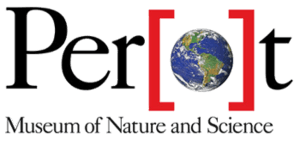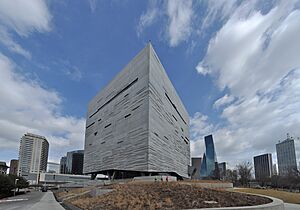Perot Museum of Nature and Science facts for kids
 |
|
| Established | 2006 |
|---|---|
| Location | Dallas, Texas, United States |
| Type | Science museum, natural history museum |
| Visitors | 1,000,000+ |
| Public transit access | |
The Perot Museum of Nature and Science, often called the Perot Museum, is an exciting place in Dallas, Texas. It is a museum about natural history and science. The museum is located in Victory Park. It was named to honor Margot and Ross Perot. Dr. Linda Abraham-Silver is the current leader of the museum.
Contents
Museum History
How the Museum Started
The Perot Museum has a long history! It started from three different museums.
- On June 6, 1936, the Dallas Museum of Natural History opened.
- On September 20, 1946, the Dallas Health Museum began. It later changed its name to the Dallas Health and Science Museum in 1958. Then, in 1981, it became the Science Place.
- In 1995, the Dallas Children's Museum was founded.
In 2006, these three museums joined together. They became one big museum at Fair Park in Dallas. This museum had an IMAX-style theater, a planetarium, and a special lab for studying ancient life.
Moving to a New Home
The museum moved to a brand new building in Victory Park on December 1, 2012. This new building was a big step for the museum. On its first day, about 6,000 people came to visit!
How the Museum Was Built
The Perot Museum's new home in Victory Park was built thanks to a huge gift. The children of Margot and Ross Perot gave $50,000,000 to help build it. This amazing donation helped the museum reach its goal of raising $185,000,000. These funds paid for the land, designing the exhibits, building the new facility, and creating educational programs. The museum was built without needing any public money or loans.
Exploring the Victory Park Campus
The museum building is very large, about 180,000 square feet. It has six floors and is as tall as a 14-story building! Five of these floors are open to visitors. They hold 11 permanent exhibit halls and 6 learning labs. The top floor is where the museum's offices are located.
Building Design
The museum building was designed by Thom Mayne. It looks like a giant cube floating above a green base. The roof is covered with plants that don't need much water, inspired by the Texas landscape. The base also has a one-acre green roof with rocks and native grasses. This shows how the building works with nature.
The museum also collects rainwater from its roof and parking lot. This water is used for 74% of the museum's non-drinking water needs and all of its watering needs.
A cool feature is the 54-foot-long escalator. It's inside a 150-foot glass case that sticks out from the building! The museum also uses LED lights and solar power to save energy. Skylights let in natural sunlight, making the building even more energy-efficient. The building has received a high rating for its green design, showing it's very friendly to the environment.
Permanent Exhibit Halls
The Perot Museum has many exciting halls to explore:
- Moody Family Children's Museum (Lower Level): Kids can climb a miniature Margaret Hunt Hill Bridge and other Dallas landmarks. You can also watch museum staff feed animals and learn about healthy food choices.
- Sports Hall (Lower Level): Race against a 3D tyrannosaurus rex or a cheetah in a 55-foot video exhibit! You can also see X-rays of sports injuries and learn about how the human body moves.
- Discovering Life Hall (Level 2): See interactive displays of three Texas ecosystems. You can experience the East Texas Piney Woods, smell beeswax from the Blackland Prairie, and hear prairie dogs in the Chihuahuan Desert. You can even create your own virtual cartoon dragon!
- Being Human Hall (Level 2): Learn how your body moves by mimicking dancers or athletes. You can see real human body parts, test a prosthetic hand, and even record your own heartbeat. In the Bio Lab, you can do cool experiments like extracting DNA.
- Texas Instruments Engineering and Innovation Hall (Level 2): Make music in a sound studio or build a robot. You can also design a model skyscraper that can stand strong during an earthquake.
- The Rees-Jones Foundation Dynamic Earth Hall (Level 3): Experience a simulated earthquake! Watch footage of real Texas tornadoes and hurricanes, and see a tornado model.
- Lyda Hill Gems and Minerals Hall (Level 3): See the world's third-largest gold nugget, called the Ausrox Gold Nugget. It weighs over 62 pounds! You can also see a 1.5-ton geode called the Grape Jelly geode.
- Tom Hunt Energy Hall (Level 3): Take a virtual trip 9,000 feet down into a gas well to learn about natural gas fracking. Learn about different types of fuels and see a giant drill bit.
- T. Boone Pickens Life Then and Now Hall (Level 4): Explore how life on Earth has changed over 4 billion years. See a 35-foot cast of an Alamosaurus and a Malawisaurus skeleton.
- Expanding Universe Hall (Level 4): Experience the Big Bang and learn how our Solar System was formed through high-definition screens.
- Rose Hall of Birds (Level 4 Mezzanine): Design your own bird by choosing its wings, songs, and feathers. Then, put on 3D glasses and watch it fly!
Temporary Exhibit Halls
The museum also has special temporary exhibits that change over time. These exhibits offer new and exciting things to see and do. Some past exhibits have included:
- Building the Building (December 2012 – May 2013): This exhibit showed how the new museum building was created.
- Recycle Reef (June 2013 – August 2013): Visitors helped build this exhibit using recycled materials.
- Animal Inside Out (September 2013 – February 2014): This exhibit showed the inside of different animals.
- World's Largest Dinosaur (April 2014 – September 2014): A huge dinosaur exhibit.
- The International Exhibition of Sherlock Holmes (February 2015 – May 2015): An exhibit about the famous detective.
- Amazing Animals: Built to Survive (June 2015 – September 2015): This exhibit explored how animals are designed to live.
- Creatures of Light: Nature's Bioluminescence (October 2015 – February 2016): This exhibit focused on animals that glow in the dark.
- Birds of Paradise (October 2016 – January 2017): This exhibit showed videos and photos of the beautiful birds-of-paradise.
- Giant Gems of the Smithsonian (September 2016 – January 2017): This exhibit displayed amazing gems from the National Museum of Natural History.
- Maya: Hidden Worlds Revealed (February 2017 – September 2017): Guests could explore ancient Maya culture through hands-on activities.
- The Science of Guinness World Records (March 2021 – September 2021): This exhibit explored the science behind amazing world records.
The Hoglund Foundation Theater
The museum has a theater with 297 seats. It shows educational films, documentaries, and other special movies in 2D and 3D.
Learning Beyond the Museum
The Perot Museum also helps teachers and students outside its walls. They create a Teacher's Guide with programs for kids from pre-kindergarten to 12th grade. These programs cover earth science, space, life science, chemistry, and engineering.
The museum offers four ways to learn:
- Field Trips: Students can visit the museum, explore the exhibits, and watch educational films.
- Onsite School Programs: Museum educators can visit schools and teach programs in classrooms or auditoriums.
- Community Engagement: The museum's TECH Truck brings hands-on science activities directly to community centers, libraries, and parks.
- The Whynauts: This is a virtual, bilingual video series that brings the museum's wonders to classrooms.
Images for kids
-
Cast skeleton of Tyrannosaurus rex in Life Then and Now hall
See Also
- List of nature centers in Texas
- List of museums in North Texas
- Heard Natural Science Museum and Wildlife Sanctuary
- Fort Worth Museum of Science and History





